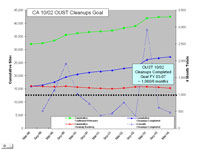Contact Pacific Southwest Waste Program
Pacific Southwest, Region 9
Serving: Arizona, California, Hawaii, Nevada, Pacific Islands, Tribal Nations
Underground Storage Tanks
| Underground Storage Tanks Quick Finder | |||
|---|---|---|---|
| UST Home | Education & Outreach | Red Hill Bulk Fuel Storage Facility |
Forms |
| Leaking USTs & Cleanup | Inspections & Enforcement | EPA & State Contacts | |
Leaking Underground Storage Tanks and Cleanup
Resources
California Orphan Site Cleanup Subaccount
Funds are available in California for the cleanup of brownfields sites contaminated by leaking underground storage tanks where there is no financially responsible party.
On This Page:
- Van's Trading Company Returns to Compliance
- Indian Country LUST Corrective Action
- Brownfields/Redevelopment Stories
- Ongoing Cleanups in Region 9
- Accelerated Cleanup Project
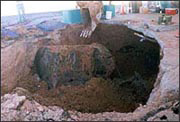
EPA's federal underground storage tank (UST) regulations require that leaking underground storage tank (LUST) sites must be cleaned up to restore and protect groundwater resources and create a safe environment for those who live or work around these sites. These sites were found to be contaminated not just from leaking underground storage tanks, but also from spills and overfills.
USTs leak for a variety of reasons. Some tanks are made of steel, which is likely to corrode over time, causing tank contents to leak into nearby soils and groundwater. Faulty installation, negligence, or inadequate operation and maintenance of UST systems also can cause a leak or a spill.
Van's Trading Company Returns to Compliance
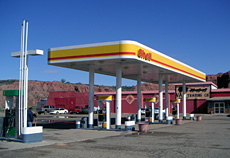
Consent Agreement and Final Order with Van's Trading Company finalized on Sept. 5, 2006 - Van's Trading Company will pay a penalty of $7,600 for underground storage tank violations relating to inadequate leak detection for pressurized piping, and not addressing the financial responsibility requirements for cleaning up accidental releases of fuel from its underground storage tanks. A RCRA inspector discovered these violations during an inspection of this facility in April 2005, and the facility has since returned to compliance. News release regarding the initial violation
Indian Country LUST Corrective Action
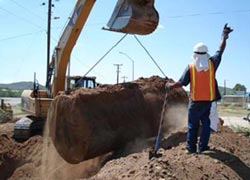
An Underground Storage Tank being lifted from the ground
Since its launch in 2005, EPA's Indian Country LUST Corrective Action Initiative continues to make significant progress. A team of scientists, engineers and attorneys has worked closely with six tribes to select 22 abandoned LUST sites on tribal lands in EPA's Pacific Southwest Region for site assessment, cleanup and closure activities. To date, EPA has closed out 15 sites and spent over $2.5 million of the Federal LUST Trust Fund.
New Policy Expands Federal
Fund Use for LUST Cleanups
With this initiative, EPA strives
to quickly and efficiently clean up
the eligible LUST sites in Indian
Country. A 2005 policy decision
from EPA Headquarters helped
kick-start this nationwide effort.
More information about the
fund.
Teaming Up with Tribes and
Contractors
Over the past two years, EPA's
Pacific Southwest Regional Office
and the tribes have worked to
determine site eligibility, and to
obtain historical preservation and
ecological clearances prior to assessing
and cleaning up contaminated contaminated
facilities. These tribes include
the following:
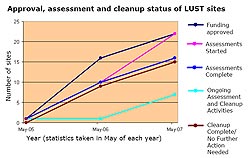
Approval, assessment and cleanup status of LUST sites
For Larger View
- Colorado River Indian Tribes
- Gila River Indian Community
- Hopi Tribe
- Navajo Nation
- San Carlos Apache Tribe
- Tohono O'Odham Nation
Progress Since Last Year
Since May 2006, EPA and the
tribes have
- Obtained approvals for assessment activities at seven sites. These activities include gathering groundwater and soil samples to determine the extent of contamination.
- Completed cleanup activities at six sites, pulling 15 tanks and removing over 500 cubic yards of contaminated soil.
- Begun conducting assessments at six additional sites.
First Large-Scale Treatment
System Activated
One of the notable projects is the
treatment system at the Arizona
Traders LUST site, a former trading
post on the Gila River Indian
Community (GRIC). The system
began operation in September
2006, and was featured in the
February 2007 issue of LUST
Line, a bulletin published by the
New England Interstate Water Pollution Control Commission ![]() .
.
Pursuing Additional Sites
EPA will continue working with
tribes to select additional sites for
assessment and cleanup. Input
and information regarding potential
eligible sites is highly valued
and important to continue the success
of this project.
Brownfields/Redevelopment
Redevelopment Stories
- Flagstaff Route 66 Corridor Assessment Grant
- Merced, City Cleanup
- Culver City Dog Park
- El Cajon Petroleum Assessment
- Tucson, AZ UST cleanup completion
- Tuba City Cleanup Project
- Arizona Traders Cleanup Project
- Accelerated Cleanup Project
- Also see the Charnock MTBE Project (Santa Monica, California) page
USTfields is the term applied to Brownfields projects involving contamination from USTs. In March 2001, Region 9 USTPO awarded its first USTfields grant to the City of Oakland to address abandoned or underutilized properties with real or perceived petroleum contamination from USTs. USTPO subsequently awarded three additional USTfields grants to the Gila River Indian Community, the City of Los Angeles, and Mineral County, Nevada.
Petroleum brownfields are sites similar to USTfields that address additional sources of petroleum contamination, such as aboveground storage tanks and oilfields. Since October 2002, USTPO has been working closely with the Region 9 Brownfields Program to manage a number of petroleum brownfields grants.
We are now beginning to see the completed redevelopment efforts for some of our USTfields and petroleum brownfields projects. Reuses include such diverse plans as affordable single-family homes, an off-leash dog park, a dance theatre and studio, and a diabetes education and research center.
Flagstaff Route 66 Corridor Assessment Grant
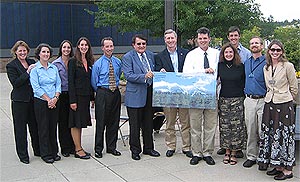
On September 8, Jeff Scott, Director of the Waste Management Division, presented a check to the Mayor of Flagstaff, Arizona for a $200,000 Brownfields grant to conduct community-wide assessment activities along Route 66. David Lloyd, Director of EPA's Office of Brownfields; Carolyn Hoskinson, Deputy Director of EPA's Office of Underground Storage Tanks; and Steve Owens, Director of ADEQ, also attended and spoke at the event, which took place during Flagstaff's Annual "Route 66 Days." The City of Flagstaff will use the grant funds to conduct community outreach, inventory sites, perform environmental site assessments, and develop a plan to redevelop cleaned up sites. Thus far, the city has not made any definitive plans for reuse but expects that many of these properties will be reused for mixed use residential and commercial purposes.
Merced Redevelopment Agency - Brownfields Assessment Grant for Downtown Site
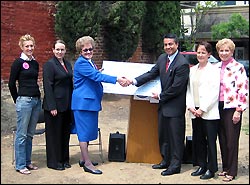
On April 26, Wayne Nastri presented a check to Mayor Ellie Wooten of Merced recognizing the award of a $200,000 Brownfields petroleum assessment grant. Merced will use the funds to assess the Simpson's Cleaners property, formerly a dry cleaners with several nearby gas stations. Additionally, the City of Merced Redevelopment Agency plans to assess human health risks and conduct community outreach activities. After the assessment, the city plans to proceed with site remediation and redevelopment. No definitive plans for reuse have been made at this point, but the city envisions the creation of a greenspace to complement the eventual structure at the site. Approximately 30 people attended the event including local print and televised media.
Culver City Dog Park -- Industrial Graveyard Turned into Pooch Playground
On Earth Day, April 22, 2006, EPA and the City of Culver City, California celebrated the grand opening of "The Boneyard," an off-leash dog park. The park is built on a former oil pumping site and was financed with $85,000 raised by the Friends of the Culver City Dog Park, a non-profit group of Culver City residents, and with two EPA Brownfields grants totaling $290,000. Jeff Scott, Director of EPA's Waste Management Division, provided remarks and participated in the ceremonial "throwing out of the first tennis ball". About 100 dogs and 300 humans attended the event.
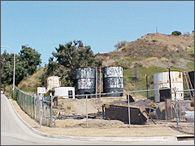

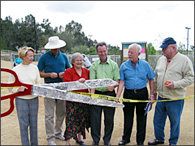
City of Culver City Dog Park Site
Press release (4/25/06)
El Cajon Petroleum Assessment Grant
On December 13, 2005, Jeff Scott, Director of the Waste Management Division presented a check to the Mayor of El Cajon, California recognizing the award of a $200,000 petroleum assessment grant. El Cajon will use the funds to assess over 100 potential LUST sites within the downtown area. Eventual redevelopment of the sites will result in downtown improvements. Jeff toured some "picturesque" LUST sites and then presented the check during a televised City Council meeting.
Thank you, EPA: The EPA recently awarded the city of El Cajon, Calif. $200,000 for downtown
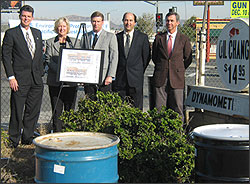
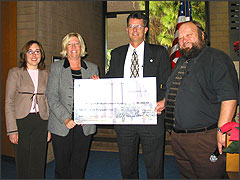
UST Cleanup Completed in Tucson, Arizona
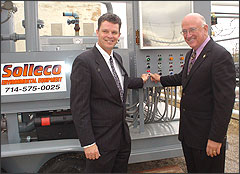
On December 12, 2005, Jeff Scott, Director of the Waste Management Division, participated in a Brownfields event celebrating the completion of a UST cleanup in Tucson, Arizona. Jeff and the Mayor of Tucson jointly shut off the soil vapor extraction unit officially ending the site cleanup activity. The site, located in Tucson's Historic Warehouse Arts District, will be redeveloped into an alternative high school with an arts focus. There were approximately 50 attendees including several members of the press.
Ongoing Cleanups in Region 9
Tuba City Cleanup Project
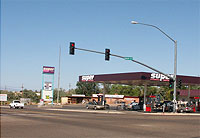
U.S. EPA, the Navajo Nation, and the Hopi Tribe directed the operators of two gas stations at the intersection of Arizona Highways 160 and 264 to assess and clean up the petroleum contamination from leaking USTs. One of the stations, Thriftway, leaked approximately 1300 gallons into soil. The quantity of leaked petroleum at the other station, Sunshine-Western, is not known. The final cleanup plan was selected after consultation with both tribes and based upon input obtained at a number of public meetings.
The leaked gasoline soaked into the soil and some chemicals entered groundwater. These chemicals flowed several hundred feet south of the site, forming a plume of contamination in the groundwater. The main chemicals of concern are benzene, toluene, ethylbenzene, and xylenes (BTEX), and methyl tertiary butyl ether (MTBE). The leaking USTs were removed and replaced with new tanks.
DocumentsThe following documents on the Tuba City cleanup are available in pdf format:
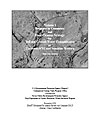 |
 |
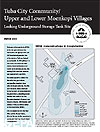 |
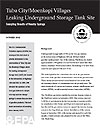 |
| Response to Comments & Final Cleanup Strategy (PDF) (52 pp, 1.6M)) |
Tuba City Fact Sheet June 2003 (PDF) (8 pp, 700K) |
Tuba City Fact Sheet March 2003 (PDF) (2 pp, 225K) |
Tuba City Fact Sheet October 2002 (PDF) (3 pp, 220K) |
Arizona Traders Cleanup Project
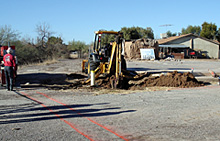
The Arizona Traders Trading Post in Sacaton, AZ is a leaking UST site with ongoing remediation. EPA determined the trading post site to be high priority based on extensive hydrocarbon releases to soil and groundwater. This is the first leaking UST site in Region 9 that met both the environmental significance and owner inability-to-pay criteria, thus making it eligible for LUST Trust Fund monies to be used. EPA is taking the lead in identifying the lateral and vertical extent of contamination from the former UST systems at this site.
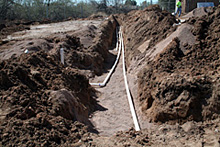
Update: EPA-lead corrective action begun at the Arizona Traders underground storage tank cleanup site - On September 7, 2006, the cleanup system for the Arizona Traders underground storage tank site was activated. The cleanup system, known as soil vapor extraction, is currently removing gasoline vapors from subsurface soil by means of extraction wells, buried piping, and a vacuum pump. The extracted vapors are being treated with a portable catalytic oxidation device prior to being released to the atmosphere. News release
Accelerated Cleanup Project
For California-specific information, see the California Accelerated Cleanup Project page.
The National strategic goal is to clean up and reduce the accumulation of leaking UST sites by 50% (approximately 70,000 sites nationwide) by 2008. Region 9's goal is to complete 2,800 cleanups annually. Most of these, over 2,100 per year are to be cleaned up in California. While Region 9 met this goal in FY 2003, future years may be more difficult due to such factors as a decrease in releases due to improved tank standards, more complex cleanups remaining, often involving oxygenates such as MTBE which take longer to remediate, and reductions in state staff conducting oversight of cleanups.

